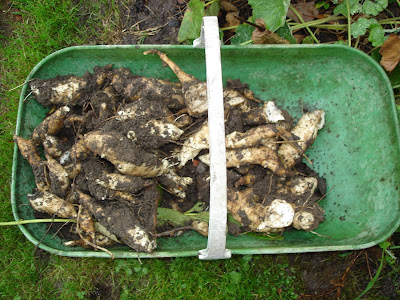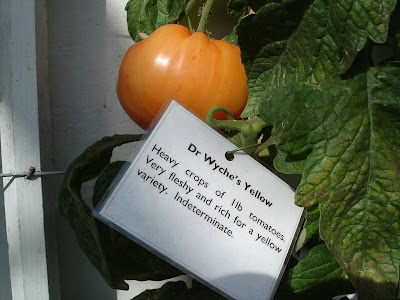So you have too much pumpkin and you don't know what to do with it all? Well, you might like to try making a traditional West Indian pumpkin soup which is made all over the Caribbean and is known universally as
'Saturday Soup' at this point I must give thanks to
DaVikka for looking after my chillis while I was on holiday. Apparently she prayed every day that they might live! - or perhaps that if they did die... they would come back to life again!!

This is actually more like a stew, and I would make it in the slow cooker and leave all the flavours to meld together. You will need:
2lbs pumpkin (diced), 1 scotch bonnet chilli (leave whole DO NOT CHOP), 3 spring onions chopped, 2 garlic cloves chopped, 1tsp dried thyme, 2 carrots, 3 sweet potatoes, 3 potatoes, 1 plantain.
Chop all the veggies (except the chilli...don't chop the chilli) and cover with water. You can season the water with salt and black pepper, and either a Maggi stock cube or preferably try to locate a packet of authentic
Jamaican pumpkin soup mix or cock soup mix (yes, that's cock soup). Towards the end of the cooking you can make the 'dumplings' which go into the soup. These are ribbons of dough about 3" long made with plain flour and water, they will thicken the soup.

I just love these homely, authentic dishes that warm the cockles of your heart. At this point I must also thank Ruth, for inspiration. She must be OK because Buddy likes her too! xxx
 Jerusalem artichokes can be a really invasive pest in the garden. They are impossible to get rid of, so even if you do want to grow them it is advisable to plant them next to a fence or in a forgotten corner of your patch. You can happily forget them and they will come up year after year and get bigger and stronger - or at least they do in my London garden.
Jerusalem artichokes can be a really invasive pest in the garden. They are impossible to get rid of, so even if you do want to grow them it is advisable to plant them next to a fence or in a forgotten corner of your patch. You can happily forget them and they will come up year after year and get bigger and stronger - or at least they do in my London garden. The name Jerusalem artichokes does not come from the place, but from the fact that they are closely related to sunflowers, the name in European languages for this is Girasole - literally - Gira - to gyrate or turn and the word soleil - the sun... to turn towards the sun. You will notice the flowers start in the morning turned towards the East and in the afternoon towards the West.
The name Jerusalem artichokes does not come from the place, but from the fact that they are closely related to sunflowers, the name in European languages for this is Girasole - literally - Gira - to gyrate or turn and the word soleil - the sun... to turn towards the sun. You will notice the flowers start in the morning turned towards the East and in the afternoon towards the West. To cook arthchokes, they need to be thoroughly cleaned first. This can be difficult due to their nobbly shape. This variety I grow - Fuseau, is supposed to be one of the least nobbliest but still you have to scrub for a while to get them clean. I steam them till cooked and then peel the skin off them when they are cool enough to handle. Serve with melted butter. You can also make a heavenly soup with artichokes, in which case you need not peel them, just pour the cooked artichokes into a blender with vegetable stock. Now this brings me to another point about Jerusalem artichokes... they give you wind! Not just any old slight rumbling, but full blown Olympic gold medal flatulence!! They have a very complex carbohydrate structure which takes a lot of digesting in your intestines. This makes them an ideal food for diabetics (who don't mind the side effects). I just love fartichokes... any way I can prepare and eat them, I do. Hours of harmless fun afterwards with close friends and family!
To cook arthchokes, they need to be thoroughly cleaned first. This can be difficult due to their nobbly shape. This variety I grow - Fuseau, is supposed to be one of the least nobbliest but still you have to scrub for a while to get them clean. I steam them till cooked and then peel the skin off them when they are cool enough to handle. Serve with melted butter. You can also make a heavenly soup with artichokes, in which case you need not peel them, just pour the cooked artichokes into a blender with vegetable stock. Now this brings me to another point about Jerusalem artichokes... they give you wind! Not just any old slight rumbling, but full blown Olympic gold medal flatulence!! They have a very complex carbohydrate structure which takes a lot of digesting in your intestines. This makes them an ideal food for diabetics (who don't mind the side effects). I just love fartichokes... any way I can prepare and eat them, I do. Hours of harmless fun afterwards with close friends and family!




































